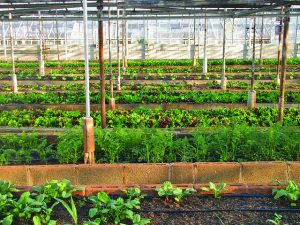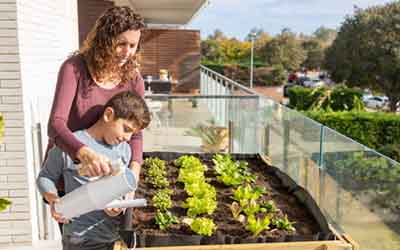Urban farming, also known as urban agriculture, is the practice of cultivating, processing, and distributing food in or around urban areas.
This innovative approach to agriculture is not just limited to traditional soil-based farming; it encompasses a variety of methods, including hydroponics, aeroponics, and vertical farming. By harnessing the potential of rooftops, vacant lots, balcony gardens, and even indoor spaces, urban farming is reimagining the way we grow and consume food.
In recent years, urban farming has witnessed a surge in popularity in cities around the globe. This trend isn’t just a fleeting hobby for city-dwellers; it’s a movement, driven by various factors.
Escalating concerns over climate change, a growing awareness about sustainable food sources, and the sheer desire for fresh, locally-produced food have all contributed to its rise.
Urban agriculture examples
Urban agriculture is making a significant impact on how cities produce and consume food.
It offers solutions to various urban challenges, such as food security, waste management, and green space provision. Let’s explore some remarkable examples of urban agriculture from around the globe.
- Rooftop Gardens
- Vertical Farms
- Edible Parks
- Aquaponics Systems
- Floating Gardens
- Window Farms
- Urban Beekeeping
- Vacant Lot Farming
- Train Station Farms
- Community Gardens
Is urban farming profitable?
The profitability of urban farming is a nuanced topic. While it holds immense potential to be profitable, various factors can influence the economic outcome, both positively and negatively.
Profitability in urban farming varies based on the location, size, method of farming, market strategies, and the crops or products being produced.
While many urban farmers focus on the social and environmental benefits of their work rather than just profit, there are indeed numerous success stories of profitable urban farming ventures.
Potential urban farmers should conduct a thorough market analysis, understand their costs, and consider innovative strategies to optimize their chances of financial success.
Factors That Enhance Profitability
- Niche Markets: Urban farms often have the advantage of being close to customers who are willing to pay a premium for fresh, locally-grown, and often organic produce.
- Direct Selling: Urban farmers can sell directly to consumers through farmers’ markets, Community Supported Agriculture (CSA) programs, or on-site stands, eliminating the need for middlemen.
- Diversification: Urban farms can diversify their product offerings to include high-value crops, value-added products like jams or sauces, and even educational workshops or farm-to-table events.
- Lower Transportation Costs: Proximity to urban consumers minimizes transportation costs and associated carbon footprints.
- Vertical Farming and Hydroponics: Innovative farming methods, such as vertical farming or hydroponics, can produce higher yields in smaller spaces, albeit with higher initial setup costs.
- Grants and Sponsorships: In some areas, urban farmers can avail of grants, subsidies, or sponsorships aimed at promoting local food production and sustainability.
Challenges to Profitability
- High Initial Costs
- Land Costs
- Regulations
- Scale
- Competition
- Skill Requirements
Environmental benefits of urban farming
The relentless march of climate change, marked by rising temperatures, erratic weather patterns, and dwindling natural resources, poses a grave threat to our planet.
Among the various solutions being proposed, urban farming emerges as a potent tool in the fight against this global menace.
- Reduction in Food Miles and Associated Carbon Footprint
- Direct Reduction in Greenhouse Gas Emissions
- Efficient Water Usage and Innovative Farming Techniques
- Reduction in Chemical Inputs
- Embracing Composting and Reducing Waste
- Understanding the Urban Heat Island Effect
- The Imperative of Urban Biodiversity
- Guardians of Pollinators
- Urban Farming is A Shield Against Erosion
- The Symbiosis of Local Food Production and Environmental Savings
- Opportunities and Environmental Stewardship
- Green Spaces as Sanctuaries for Mental Health
- Strengthening Community Bonds Through Shared Soil
Reduction in Food Miles and Associated Carbon Footprint
One of the most significant contributions of urban farming to combating climate change lies in the reduction of “food miles.” The term ‘food miles’ refers to the distance food travels from the point of production to the consumer’s plate.
Traditional agricultural practices often involve transporting food across vast distances, sometimes even internationally. This not only diminishes the freshness and nutrient content of the food but also results in significant carbon emissions due to the extensive use of fossil fuels in transportation.
Urban farming, by virtue of its location within city limits or its periphery, drastically cuts down these food miles. Produce grown in rooftop gardens, community plots, or indoor farms can be consumed within the same locality, sometimes even on the same premises.
Direct Reduction in Greenhouse Gas Emissions
Traditional farming practices are major contributors to greenhouse gas emissions. These emissions arise from various sources, including the use of synthetic fertilizers and pesticides, mechanized farming equipment, and the conversion of forests into farmland.
Such practices release vast amounts of carbon dioxide, methane, and nitrous oxide—three of the primary greenhouse gases.
Efficient Water Usage and Innovative Farming Techniques
Water scarcity is a pressing concern, especially in urban landscapes where the demand is perpetually high.
Traditional farming can be notoriously water-intensive. However, urban farms are changing this narrative with the adoption of innovative, water-conserving techniques:
This soilless cultivation method uses a nutrient-rich water solution to feed plants. Since the system is often closed-loop, with water being recirculated, it can use up to 90% less water than conventional farming methods.
- Aquaponics
Integrating fish farming with plant cultivation, aquaponics creates a symbiotic environment. Fish waste provides nutrients for plants, while plants help filter and clean the water, which is then recirculated back to the fish tanks. Like hydroponics, this system requires significantly less water compared to traditional farming.
Reduction in Chemical Inputs
Urban farming often takes place in smaller plots, terraces, or even indoor environments. The scale and intimacy of these setups allow farmers to have better control over their crops.

Embracing Composting and Reducing Waste
One of the hallmark practices of urban farming is composting. Composting transforms organic kitchen and garden waste into nutrient-rich compost, which can be reintroduced into the soil, completing a natural cycle:
Compost introduces beneficial microorganisms to the soil and improves its texture, water retention capacity, and overall health. This leads to more robust plant growth without the need for synthetic fertilizers.
For urban farmers, making compost onsite means a constant supply of free, high-quality fertilizer, reducing the costs associated with buying commercial fertilizers.
Understanding the Urban Heat Island Effect
At its core, the UHI effect refers to the significantly warmer temperatures experienced in urban areas compared to their rural surroundings. Several factors contribute to this:
Urban areas are characterized by vast expanses of concrete, asphalt, and other man-made materials. These materials absorb and retain heat much more efficiently than natural surfaces like soil or vegetation.
The Imperative of Urban Biodiversity
Biodiversity, the variety of life in all its forms, is a testament to Earth’s complex and balanced ecosystems. In cities, biodiversity:
A diverse ecosystem is more resilient to diseases and pests. It also adapts better to changes, providing a buffer against environmental stresses.
From pollination to decomposition, biodiversity plays a role in essential services that keep ecosystems functioning smoothly.
Guardians of Pollinators
Pollinators like bees, butterflies, and certain birds are vital for food production, playing a pivotal role in the reproduction of over 85% of flowering plants.
Many urban farmers incorporate flowering plants that attract and nourish pollinators. Such plants provide nectar and pollen, essential food sources for these creatures.
Organic and sustainable urban farming practices often minimize or eliminate the use of harmful pesticides. This creates a safer environment for pollinators, many of which are sensitive to these chemicals.
Urban farms can collaborate with local beekeepers, providing space for hives. This not only aids in pollination but also helps in honey production and boosts bee populations.
Urban Farming is A Shield Against Erosion
Introducing farming into urban spaces can mitigate soil erosion effectively. For sloped urban areas, especially in hilly cities, terracing is a brilliant solution. Terraced urban farms reduce the speed of runoff, allowing water to percolate and minimizing soil wash-off.
Planting cover crops like clover or vetch can protect soil from the direct impact of raindrops. These crops, with their dense root systems, hold the soil together. Rotating crops also ensures soil health, with different plants contributing varied nutrients to the soil.
Urban farmers often use mulching to cover the soil surface. Mulch, whether organic like straw or inorganic like gravel, protects the soil from erosive forces and retains moisture.
The Symbiosis of Local Food Production and Environmental Savings
The concept of “local” has significant economic and environmental repercussions. Growing food within city limits slashes the need for long-haul transportation. This results in direct savings in fuel costs and associated expenses, making local produce potentially more cost-effective for both producers and consumers.
Fewer trucks on highways mean fewer emissions. The carbon footprint of food shrinks dramatically when it’s consumed close to its place of origin. This local-centric approach not only reduces greenhouse gas emissions from transportation but also diminishes road wear-and-tear, cutting down maintenance costs.
Opportunities and Environmental Stewardship
Urban farming is not just about plants and produce; it’s about people. The rise of urban agriculture ushers in a plethora of job opportunities:
Urban farms need managers, gardeners, and sales personnel. As these farms proliferate, they can become significant employers within city limits.
The ripple effect of urban farming is expansive. From suppliers of organic farming inputs to experts in innovative farming technologies like hydroponics, numerous sectors can witness job growth.
Green Spaces as Sanctuaries for Mental Health
Green spaces in urban settings have long been associated with a multitude of psychological benefits.
Natural settings, even within urban confines, have been shown to reduce cortisol levels, a primary stress hormone. The act of gardening or merely being in a green environment can be a potent antidote to urban stressors.
Interacting with nature, even on a small urban farm, can boost mood and reduce feelings of anxiety and depression. The sensory experience – from the smell of earth to the sight of verdant growth – is therapeutic.
Nature has a restorative effect on mental fatigue. Urban dwellers, especially those with demanding jobs, can rejuvenate their cognitive abilities by spending time in urban green spaces, enhancing focus and productivity.
Strengthening Community Bonds Through Shared Soil
Urban farms are more than just plots of land; they are communal hubs where people come together.
In cities where anonymity often prevails, urban farms offer spaces for people to interact, share, and collaborate. Planting, tending, and harvesting together can cultivate not just crops but also relationships.
Urban farms can serve as open-air classrooms, educating community members about sustainable agriculture, nutrition, and environmental conservation. Knowledge dissemination in such informal settings can lead to more profound, lasting impacts.
My final thought on Environmental benefits of urban farming
Urban farming is a revolution unfolding on rooftops, backyards, and reclaimed city lots, represents more than just an agricultural shift—it’s a transformative approach to redefining urban living.
Through its multifaceted benefits, from mitigating the heat island effect and conserving biodiversity to fostering community bonds and boosting mental well-being, urban agriculture illustrates the intricate connection between the environment, economy, and societal health.
As our world becomes increasingly urbanized and the challenges of climate change intensify, urban farming emerges as a beacon of sustainable resilience.
It’s not merely about producing fresh, local food but about rejuvenating urban ecosystems, fostering biodiversity, and nurturing a symbiotic relationship between nature and urban dwellers.
By embracing and integrating urban farming into the fabric of city life, each individual can play a part in ushering in a sustainable, environmentally harmonious future.
Recommendations
Best precision agriculture technologies
How To Become An Agriculturist



